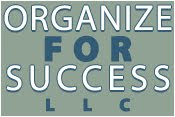Although you might be familiar with the phrase "location, location, location" that's frequently used by realtors when you are searching for the ideal spot to live or work, but did you know it's equally applicable for organizing your workspace to be another tool in your productivity toolbox? It is with this mantra that you can be certain each item in your office is assigned a home that works for your needs.
In real estate, "location, location, location" applies to finding a home that's close to what amenities or destinations you want to easily access for an ideal life or finding a business spot that's in close proximity to your clients. Alternatively, when it comes to organizing your workspace, this refrain applies equally well to prioritizing the space within arm's reach from where you spend most of your working hours, assigning homes to what's in your office based on how frequently you use each item.
The second Monday of January each year is recognized as National Clean Off Your Desk Day, making today the ideal opportunity to begin your new year with a clean and organized workspace. Whether in a private or shared office, in your home or in a cubicle, having a desk that is uncluttered and designed for your success helps you work more efficiently, making today the perfect time to consider the "location, location, location" of what's atop your desk.
Step one is to evaluate anything atop your desk and make sure you need or want to keep it there. Retain only what is accurate, applicable, useful or bringing you joy. Decide what to trash, recycle, donate, move elsewhere or keep in your space. Remember that the less you have in your office then the less you need to sift through to quickly find what's needed.
Step two is to determine how often you utilize each item you are planning to keep. Physical items, papers, files or tools that you use more frequently earn a higher priority and can be kept closer to where you sit; alternatively, anything used rarely can be moved farther away. It is by knowing how often something is used that you can proceed through the organizing process.
Step three is to use those determinations in assigning homes for what's to remain. When something is assigned a home, you can more seamlessly return it to that location after each time you use it, meaning assigned homes can save time while lessening the stress of decision-making. When possible, group related items together, and position items near where they will be used. Anything used more frequently should be assigned space closer to you while less frequently used items move further away based on how much often less they get utilized.
Step four is to replicate the same process you used in cleaning off your physical desktop to clean off your computer's desktop. Those same principles that I mentioned previously apply to your technology; plus, when your computer home screen is cluttered, it slows down how well your laptop or desktop works, particularly if you use a PC as opposed to a Mac.
Pause for a moment to celebrate all the desktop you can now see and, then, schedule time to maintain the systems you created. Maybe you'll schedule time at the end of each day to put away what items have found their ways atop your desk. Maybe you'll commit to getting caught back up at the end of each week. Choose a maintenance system that works for your specific workflow and personality, but make sure to select some method of keeping that desk cleaned off so you continue to reap the benefits of greater organization and enhanced productivity.
Subscribe to:
Post Comments (Atom)


No comments:
Post a Comment